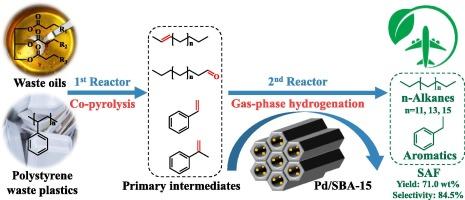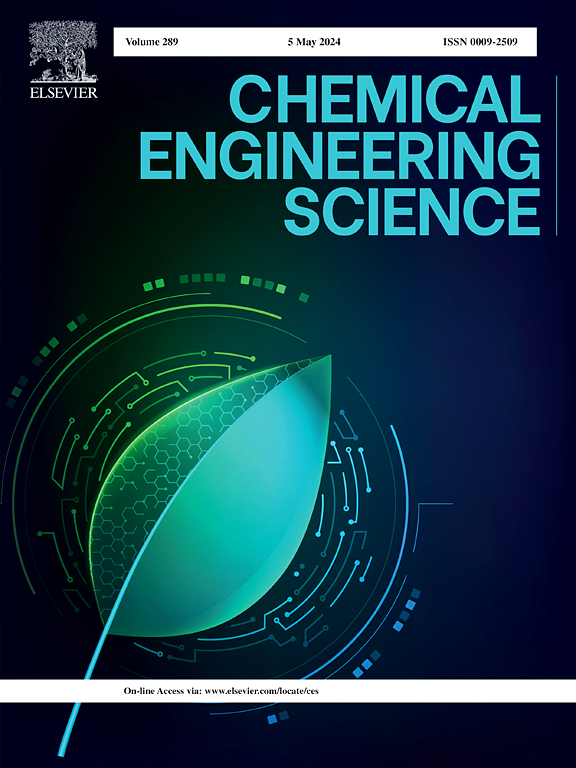可持续航空燃料的无芳构化策略:将废油和聚苯乙烯塑料共同升级为烷烃和芳烃
IF 4.1
2区 工程技术
Q2 ENGINEERING, CHEMICAL
引用次数: 0
摘要
可持续航空燃料(SAF)是减少航空相关碳排放的一种有前途的解决方案。然而,传统的SAF生产方法(如废油芳构化)面临着复杂的加工要求和产生有害的多环芳烃(PAHs)等挑战。本研究提出了一种新的、无芳构化的方法,通过共同升级回收废油和聚苯乙烯(PS)塑料来生产SAF。利用聚苯乙烯塑料中固有的芳环结构直接形成芳烃,绕过了传统芳构化的需要。采用两级加压固定床反应器,废油与PS共加氢热解生成中间体,再进行气相催化加氢。在优化条件下(0.15 MPa H2, 480 ℃共加氢,350 ℃共加氢,5 mg Pd/SBA-15催化剂),该工艺得到71.0 wt% C8-C16喷气燃料组分,选择性84.5 %。相比之下,较高酸度的催化剂,如Pd/HZSM-5和Pd/USY,促进了裂化等副反应,导致较低的产液率(分别为35.7 wt%和18.1 wt%)和更复杂的产物混合物。此外,Pd/SBA-15催化剂表现出优异的稳定性,在10次重复循环中保持一致的催化性能,并显示出对各种废塑料和油的可扩展性。该研究强调了废油和PS塑料共同升级回收的可行性,为简化SAF生产提供了一条高效、可持续的途径,同时减少了与传统方法相关的环境影响。本文章由计算机程序翻译,如有差异,请以英文原文为准。


Aromatization-free strategy for sustainable aviation fuel: Co-upcycling waste oils and polystyrene plastics into alkanes and aromatics
Sustainable aviation fuel (SAF) is a promising solution for reducing aviation-related carbon emissions. However, conventional SAF production methods such as waste oil aromatization face challenges like complex processing requirements and the generation of unwanted polycyclic aromatic hydrocarbons (PAHs). This study presents a novel, aromatization-free approach to SAF production by co-upcycling waste oils and polystyrene (PS) plastics. The inherent aromatic ring structures in PS plastics are utilized to directly form aromatic hydrocarbons, bypassing the need for traditional aromatization. A two-stage pressurized fixed-bed reactor was employed, where waste oils and PS underwent co-hydropyrolysis to generate intermediates, followed by gas-phase catalytic hydrogenation. Under optimized conditions (0.15 MPa H2, 480 °C for co-hydropyrolysis, 350 °C for hydrogenation, and 5 mg Pd/SBA-15 catalyst), this process yielded 71.0 wt% C8-C16 jet fuel components, with 84.5 % selectivity. In comparison, catalysts with higher acidity, such as Pd/HZSM-5 and Pd/USY, promoted side reactions like cracking, leading to lower liquid yields (35.7 wt% and 18.1 wt%, respectively) and a more complex product mixture. Additionally, Pd/SBA-15 catalyst demonstrated excellent stability, maintaining consistent catalytic performance over 10 repeated cycles, and showed potential for scalability with a variety of waste plastics and oils. The study underscores the feasibility of co-upcycling waste oils and PS plastics, offering an efficient, sustainable pathway to streamline SAF production while reducing the environmental impacts associated with conventional methods.
求助全文
通过发布文献求助,成功后即可免费获取论文全文。
去求助
来源期刊

Chemical Engineering Science
工程技术-工程:化工
CiteScore
7.50
自引率
8.50%
发文量
1025
审稿时长
50 days
期刊介绍:
Chemical engineering enables the transformation of natural resources and energy into useful products for society. It draws on and applies natural sciences, mathematics and economics, and has developed fundamental engineering science that underpins the discipline.
Chemical Engineering Science (CES) has been publishing papers on the fundamentals of chemical engineering since 1951. CES is the platform where the most significant advances in the discipline have ever since been published. Chemical Engineering Science has accompanied and sustained chemical engineering through its development into the vibrant and broad scientific discipline it is today.
 求助内容:
求助内容: 应助结果提醒方式:
应助结果提醒方式:


